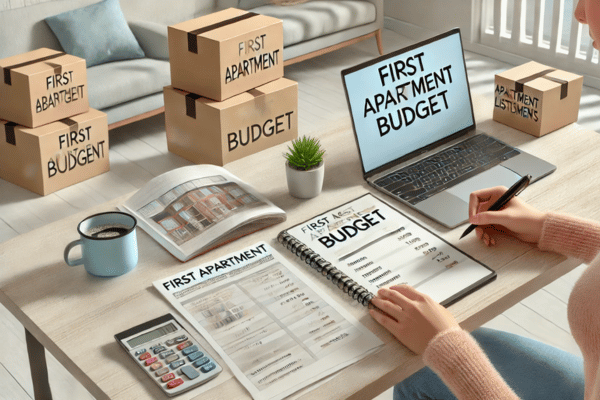Moving into your first apartment is an exciting step toward independence — but it also comes with serious financial responsibility. Without a solid plan in place, it’s easy to underestimate the costs involved and quickly fall into debt or financial stress. Budgeting properly before you sign a lease is key to enjoying your new space without regrets.
In this guide, we’ll break down how to budget for your first apartment realistically, covering everything from rent and utilities to hidden move-in costs and long-term financial planning.
Understand Your Total Income
Before you start apartment hunting, take a close look at your income. This includes your take-home pay after taxes, and any side income from freelance work, part-time jobs, or other sources. The total amount you earn each month is the foundation of your budget — you should never spend more than this amount.
Write down your average monthly income and be conservative in your estimates. If your income varies, use the lowest monthly amount you typically earn to stay on the safe side.
Use the 30% Rule for Rent
A popular guideline suggests that no more than 30% of your monthly income should go toward rent. This helps ensure you have enough left over for other expenses like utilities, food, transportation, and savings.
For example, if you bring home $3,000 per month, aim for rent that doesn’t exceed $900. In high-cost cities, this can be difficult, but sticking as close as possible to this limit will give you more financial flexibility and peace of mind.
List All Initial Move-In Costs
Securing your first apartment usually requires upfront payments beyond your first month’s rent. These may include:
- Security deposit: Typically equal to one month’s rent.
- First and last month’s rent: Some landlords require both at signing.
- Application fee: A non-refundable fee for background and credit checks.
- Moving expenses: Hiring movers or renting a truck, plus supplies like boxes and tape.
- Furniture and household items: Beds, kitchen essentials, cleaning supplies, curtains, and more.
- Utility setup fees: Some services charge activation or installation fees.
Add these one-time expenses together so you’re not caught off guard. This initial budget is crucial for determining how much you need to save before making the move.
Include Monthly Recurring Expenses
Once you’re moved in, your monthly expenses will go far beyond just rent. Be sure to include the following in your monthly budget:
- Utilities: Electricity, water, gas, trash, and possibly heating or cooling.
- Internet: A stable connection is essential for work, school, or entertainment.
- Renter’s insurance: An often-overlooked cost, but important for protecting your belongings.
- Groceries: Food is a major monthly cost, and cooking at home is more affordable than eating out.
- Transportation: Gas, public transit, or rideshare costs if you commute.
- Phone bill: Monthly cell phone service and any associated fees.
- Streaming services: Optional, but many people include them in their entertainment budget.
- Maintenance and cleaning: Household items like light bulbs, toilet paper, and cleaning supplies.
These monthly expenses can add up quickly, so keep track of each one and round up when estimating costs to build in a buffer.
Create a Realistic Budget Plan
Now that you have a sense of your income and expenses, it’s time to build a realistic budget. Start by listing your net income at the top and subtracting your projected expenses for each category.
Example for a $3,000 monthly income:
- Rent: $900
- Utilities: $150
- Internet: $60
- Groceries: $400
- Transportation: $150
- Renter’s Insurance: $20
- Phone: $70
- Entertainment: $100
- Savings: $300
- Miscellaneous: $100
Total: $2,250
This leaves $750 for additional savings, emergency expenses, or debt repayment. If your projected expenses exceed your income, you’ll need to make adjustments by looking for a less expensive apartment or cutting discretionary spending.
Set Aside Money for Emergencies
Life is unpredictable, and emergencies will happen — whether it’s a car repair, medical bill, or job loss. Start building an emergency fund with at least $500 to $1,000 to cover unexpected expenses without going into debt.
If you can, continue contributing a small amount each month until you reach 3 to 6 months’ worth of living expenses. This safety net will give you more confidence and reduce stress as you navigate your new responsibilities.
Don’t Forget Long-Term Financial Goals
It’s easy to focus only on monthly survival when you first move out, but budgeting should also help you build a secure future. Include savings for long-term goals such as:
- Building a larger emergency fund
- Paying off student or credit card debt
- Saving for a car or home
- Investing for retirement
Even small contributions toward these goals can make a big difference over time. Treat them as fixed expenses in your budget so they become consistent habits.
Tips to Stay on Budget
- Track every expense: Use a notebook, spreadsheet, or budgeting app to record spending.
- Cook at home: Meal planning can save hundreds per month compared to takeout.
- Shop secondhand: Furniture and household items are often available at thrift stores or online marketplaces.
- Set spending limits: Know your limits for non-essentials like dining out or online shopping.
- Review monthly: Check your budget regularly and adjust based on actual spending.
Final Thoughts: Build Your Independence the Smart Way
Moving into your first apartment is a major milestone, but without a well-thought-out budget, it can quickly become overwhelming. By planning ahead, estimating costs accurately, and making intentional spending decisions, you can enjoy your new home while building strong financial habits that last a lifetime.
Take control of your money before you move in — and your first apartment experience will be a confident and rewarding step into adulthood.
